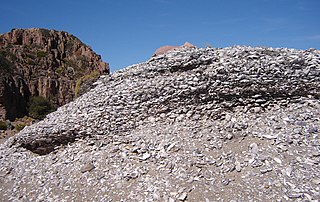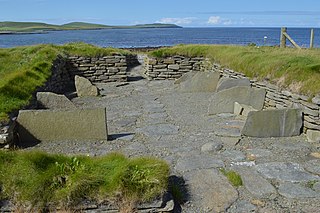Related Research Articles

A midden is an old dump for domestic waste which may consist of animal bone, human excrement, botanical material, mollusc shells, potsherds, lithics, and other artifacts and ecofacts associated with past human occupation.

Sand on the Applecross Peninsula in Wester Ross, Scotland, is an archaeological site.

Native American pottery is an art form with at least a 7500-year history in the Americas. Pottery is fired ceramics with clay as a component. Ceramics are used for utilitarian cooking vessels, serving and storage vessels, pipes, funerary urns, censers, musical instruments, ceremonial items, masks, toys, sculptures, and a myriad of other art forms.

The Caroni River is the largest river in Trinidad and Tobago, running for 40 km (25 mi) from its origins in the Northern Range on the island of Trinidad, through the northern lowlands of the Caroni Plains and enters the Gulf of Paria at the Caroni Swamp.
Banwari Trace, an Archaic (pre-ceramic) site in southwestern Trinidad, is the oldest archaeological site in the Caribbean. The site has revealed two separate periods of occupation; one between 7200 and 6100 BP and the other between 6100 BP and 5500 BP.

Horr's Island is a significant Archaic period archaeological site located on an island in Southwest Florida formerly known as Horr's Island. Horr's Island is on the south side of Marco Island in Collier County, Florida. The site includes four mounds and a shell ring. It has one of the oldest known mound burials in the eastern United States, dating to about 3400 radiocarbon years Before Present (BP). One of the mounds has been dated to as early as 6700 BP. It was the largest known community in the southeastern United States to have been permanently occupied during the Archaic period.

Namu is a small fishing port, former cannery town and First Nations community on the coast of British Columbia, Canada. It is located about 95 km (59.0 mi) southwest of Bella Coola or 35 km (21.7 mi) SSE of Bella Bella, on the mainland shore of the Inside Passage ferry route directly opposite Hunter Island, and just south of the opening of Burke Channel and King Island. The community's harbour is named Namu Harbour, and a large lake just inland is Namu Lake, which lies in the short drainage basin of the 15 km Namu River, immediately east of which is the small but rugged Namu Range.
The Ortoiroid people were the second wave of human settlers of the Caribbean who began their migration into the Antilles around 2000 BCE. They were preceded by the Casimiroid peoples. They are believed to have originated in the Orinoco valley in South America, migrating to the Antilles from Trinidad and Tobago to Puerto Rico. The name "Ortoiroid" comes from Ortoire, a shell midden site in southeast Trinidad, they have also been called Banwaroid after another archaeological site in Trinidad

The Marmes Rockshelter is an archaeological site first excavated in 1962, near Lyons Ferry Park and the confluence of the Snake and Palouse Rivers, in Franklin County, southeastern Washington. This rockshelter is remarkable in the level of preservation of organic materials, the depth of stratified deposits, and the apparent age of the associated Native American human remains. The site was discovered on the property of Roland Marmes, and was the site of the oldest human remains in North America at that time. In 1966, the site became, along with Chinook Point and the American and English Camps on San Juan Island, the first National Historic Landmarks listed in Washington. In 1969, the site was submerged in water when a levee protecting it from waters rising behind the then newly constructed Lower Monumental Dam, which was 20 miles (32 km) down the Snake River, failed to hold back water that leaked into the protected area through gravel under the soil, creating Lake Herbert G. West.
Archaeology of Bocas del Toro, Panama: The province of Bocas del Toro in Panama has a rich history, beginning with the first European visitors: Christopher Columbus and his son Fernando in 1502 on Columbus’ fourth voyage to the New World. The area was visited frequently from the middle of the 17th century to the middle of the 18th century by privateers and buccaneers marauding Spanish colonial towns and the ships carrying gold to Europe. However little is known of the inhabitants of the region before the time of European contact. Archaeological research conducted since the middle of the 20th century has begun to illuminate the cultural history as well as development of societies in the region prior to Columbus arriving.
Garden Creek site is an archaeological site located 24 miles (39 km) west of Asheville, North Carolina in Haywood County, on the south side of the Pigeon River and near the confluence of its tributary Garden Creek. It is near modern Canton and the Pisgah National Forest. The earliest human occupation at the site dates to 8000 BCE. The 12-acre site features remains of two villages (31Hw7) occupied first in the Woodland period and, most prominently, in the Pisgah phase associated with the South Appalachian Mississippian culture. A total of four earthwork mounds have been found at the site; three have been excavated.

Shell rings are archaeological sites with curved shell middens completely or partially surrounding a clear space. The rings were sited next to estuaries that supported large populations of shellfish, usually oysters. Shell rings have been reported in several countries, including Colombia, Peru, Japan, and the southeastern United States. Archaeologists continue to debate the origins and use of shell rings.
The Sixtoe Mound site (9MU100) is an archaeological site in Murray County, Georgia excavated by Arthur Randolph Kelly from 1962-1965 as a part of the Carters Dam project conducted for the National Park Service by the University of Georgia. The site consisted of a low platform mound and an associated village. The majority of the mound was excavated, while the village received little excavation.
John Albert Bullbrook was an author, archaeologist and archaeological historian, who went to Trinidad in 1913 as a petroleum geologist. He began his archaeological career in 1919, pioneering the search on the indigenous population of Trinidad.
Benjamin Irving Rouse was an American archaeologist on the faculty of Yale University best known for his work in the Greater and Lesser Antilles of the Caribbean, especially in Haiti. He also conducted fieldwork in Florida and Venezuela. He made major contributions to the development of archaeological theory, with a special emphasis on taxonomy and classification of archaeological materials and studies of human migration.
The Carlston Annis Shell Mound is a prominent archaeological site in the western part of the U.S. state of Kentucky. Located along the Green River in Butler County, this shell midden has been declared a historic site because of its archaeological value.
Elands Bay Cave is located near the mouth of the Verlorenvlei estuary on the Atlantic coast of South Africa's Western Cape Province. The climate has continuously become drier since the habitation of hunter-gatherers in the Later Pleistocene. The archaeological remains recovered from previous excavations at Elands Bay Cave have been studied to help answer questions regarding the relationship of people and their landscape, the role of climate change that could have determined or influenced subsistence changes, and the impact of pastoralism and agriculture on hunter-gatherer communities.

The Taino were the indigenous people of the Caribbean and the principal inhabitants of Cuba, the Dominican Republic, Haiti, Jamaica, and Puerto Rico. Caribbean archaeologists have theorized that by the mid 16th century the native people of the Caribbean were extinct. However, the story of Taino extinction may not be the case according to recent research and archaeological findings.
Seafaring has played an important role in human history by enabling many prehistoric migration events across the world. Seafaring is especially important in the Caribbean as it represents the only possibility in reaching the Caribbean Islands. Current research has discovered that numerous Pre-Columbian colonisation events occurred in the Caribbean and that an important initial incentive to visit the Caribbean Islands may have been the search for high quality materials, such as flint, clams and oysters and other resources. Although only a limited amount of Pre-Columbian watercraft have been uncovered it has been possible to deduce the appearance and design of some Caribbean canoes. Historical sources offer a plethora of descriptions regarding the appearance and use of Amerindian canoes, however, it is difficult to assess to what extent the Caribbean canoes from the 15th century AD are similar to their counterparts around 5000 years earlier.

Quoygrew, Westray is the site of a medieval Norse settlement on the island of Westray in Orkney, Scotland. Established as a small farmstead most likely between 900 and 1000 AD, and later expanded in 1200, Quoygrew includes the remains of medieval and post-medieval buildings that range in date from the 10th to the 16th centuries. The 1 hectare farmstead has been in continuously occupied until the early 20th century. Historic Environment Scotland established the site as a scheduled monument in 2014.
References
- ↑ Saunders, Nicholas J. The Peoples of the Caribbean: an Encyclopedia of Archeology and Traditional Culture. ABC-CLIO, 2005. ISBN 978-1-57607-701-6.
- ↑ "Summary of Trinidad Archeology 1973" (PDF).
- ↑ "Antigua". World-archaeology.com. September 7, 2007. Retrieved December 12, 2020.
- ↑ Basil A Reid (May 16, 2018). The Archaeology of Caribbean and Circum-Caribbean Farmers (6000 BC - AD 1500). Taylor & Francis. pp. 163–. ISBN 978-1-351-16918-9.
- ↑ "The Ortoire River and Ortoire Beach Front". September 16, 2016. Retrieved December 14, 2020.